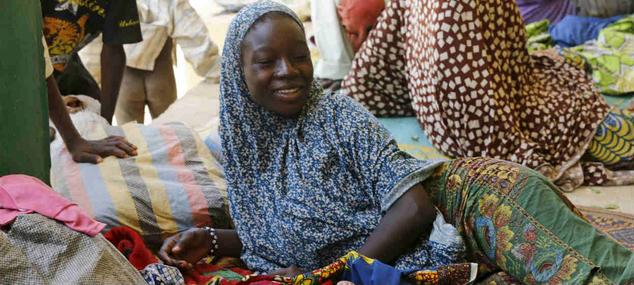Story Highlights
- Future life evaluations increased most in Zimbabwe
- Scores were highest in Nigeria
- Lowest scores were in Tanzania and Chad
This article is part of a series on well-being and development trends in sub-Saharan Africa, focusing on 12 nations that Gallup has surveyed every year since 2007.
WASHINGTON, D.C. -- Residents in seven out of the 12 African nations that Gallup has polled every year since 2007 are now more optimistic about their future lives than they were when they were first surveyed. For the residents of the other five, the future looks the same as or worse than before. Between 2007 and 2014, ratings increased most in Zimbabwe and deteriorated most in Ghana.

In each of these 12 countries -- which represent 40% of the population of sub-Saharan Africa aged 15 and older, or about 300 million adults -- Gallup asks residents to rate their lives five years from now on a scale based on the Cantril Self-Anchoring Striving Scale. On the scale, zero represents the worst possible life and 10 is the best possible life.
Although Zimbabweans' future life ratings reflect the most improvement since 2007, Nigerians had the most positive outlook on their lives in 2014, with an average rating of 7.9. The lowest average rating, 5.6, was in Tanzania.
In Western Africa, Future Life Outlook Is Stable in Nigeria and Cameroon
Including last year, residents in the Western African country of Nigeria have had the highest positive outlook for their future lives in six of the past eight years. However, their expectations have been relatively flat, with the exception of a spike to 8.6 in 2011.
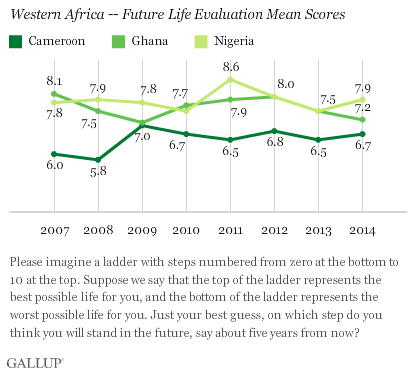
In 2007, Ghanaians had the highest average future life ratings out of all 12 populations, at 8.1. But since then, their ratings have ebbed and flowed. Ghanaians' ratings in 2014 are 0.9 points lower than where they stood in 2007, representing the largest decline among all 12 countries. Cameroonians' future life ratings have stabilized in higher territory after languishing near an average of 6.0 in 2007 and 2008.
Chad Departs From Other Sahel Nations in Outlook for Future
In 2007, the future life evaluation scores of residents of four countries in the Sahel -- Chad, Mauritania, Niger and Senegal -- were clustered within a narrow range of 0.3 points. By 2014, Mauritania, Niger and Senegal had each seen increases in their residents' scores and remained within the same 0.3-point cluster. Chad experienced the most fluctuation over time and now has the least positive future life evaluation of all residents surveyed in the Sahel region, at 5.9.
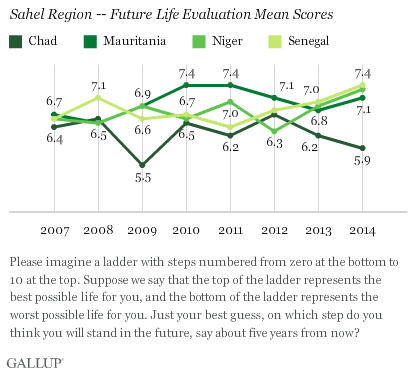
Tanzania Maintains Lowest Life Outlook Scores in Eastern Africa
In the Eastern region, Kenyans and Ugandans have evaluated their future lives similarly over time, although the former was one point higher than the latter in 2014 -- 7.0 and 6.0, respectively. Tanzanians, meanwhile, have consistently evaluated their future lives well below 6.0 every year, dropping below 5.0 in 2009. Their hope of a better future was essentially at the same level in 2014 (5.6) as it was eight years ago (5.7), and it is the lowest future life evaluation of all African countries surveyed over this time period.
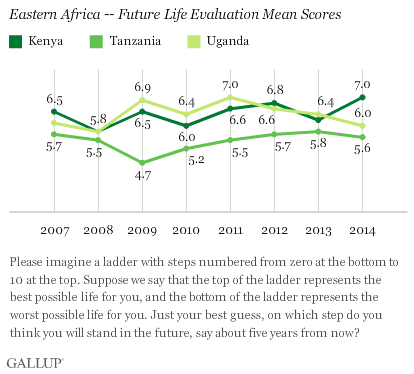
In Southern Africa, an Increase in Zimbabweans' Outlook for Future Lives
Since 2007, South Africans have evaluated their future lives more positively than Africans in most other countries surveyed, averaging 7.0 or better in most years. However, South Africans' ratings of their future lives did drop significantly at two points. The first occurred between 2008 and 2009, when they fell from 7.8 to 7.2, at a time when the country experienced a large increase in unemployment. The second drop in South Africans' ratings of their future lives occurred in 2013, when they dropped to 6.9 from 7.7 the previous year. Nelson Mandela, who was considered the Father of the South African nation, died during the survey field period.
The outlook of their Zimbabwean neighbors has improved a great deal since 2007, when their average future life ratings were below 4.0. At that time, hyperinflation plagued the country, and it was only in 2009 -- when the government allowed the use of foreign currencies -- that residents started to feel improvement. Zimbabweans' ratings of their future lives continued to increase until 2011 and 2012, when they peaked at 7.4. However, they have started to drop again and reached 6.0 in 2014, erasing gains over several years of consistently positive ratings.
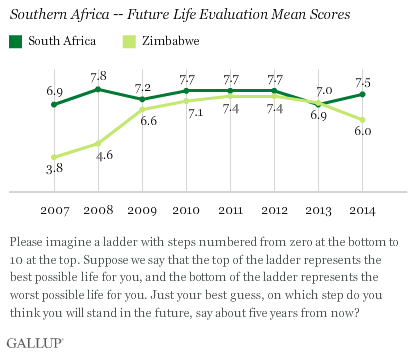
Implications
In September, the United Nations is expected to announce the 17 Sustainable Development Goals (SDGs), which are designed to provide a more comprehensive framework for human development for the next 15 years. Scientists who have reviewed the SDGs, as currently proposed, have recommended that new indicators capturing the multidimensional aspects of well-being be developed. As such, the Gallup findings provide a powerful and reliable mechanism to monitor progress in life evaluations across sub-Saharan Africa.
Diana Liu contributed analysis to this article.
The data in this article are available in Gallup Analytics.
Survey Methods
Results are based on face-to-face interviews with at least 1,000 adults, aged 15 and older, conducted every year between 2007 and 2014 in Cameroon, Chad, Ghana, Kenya, Mauritania, Niger, Nigeria, Senegal, South Africa, Tanzania, Uganda and Zimbabwe. For results based on the total sample of national adults in each country across all years, the median margin of sampling error is ±3.8 percentage points at the 95% confidence level. All reported margins of sampling error include computed design effects for weighting.
For more complete methodology and specific survey dates, please review Gallup's Country Data Set details. Learn more about how the Gallup World Poll works.
